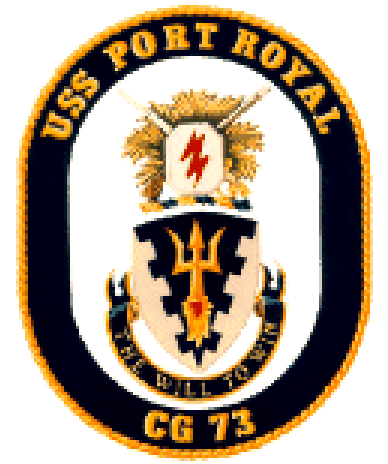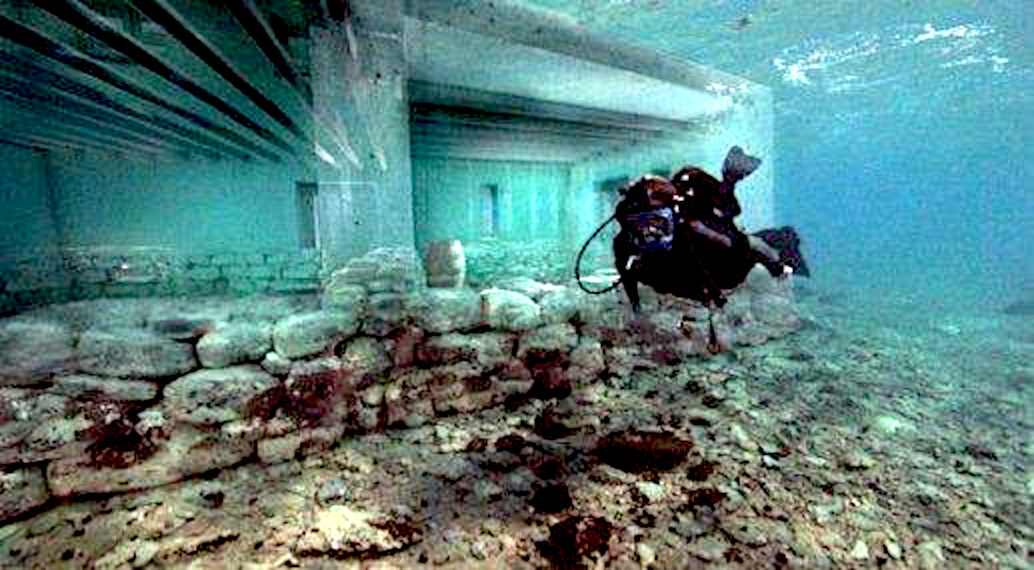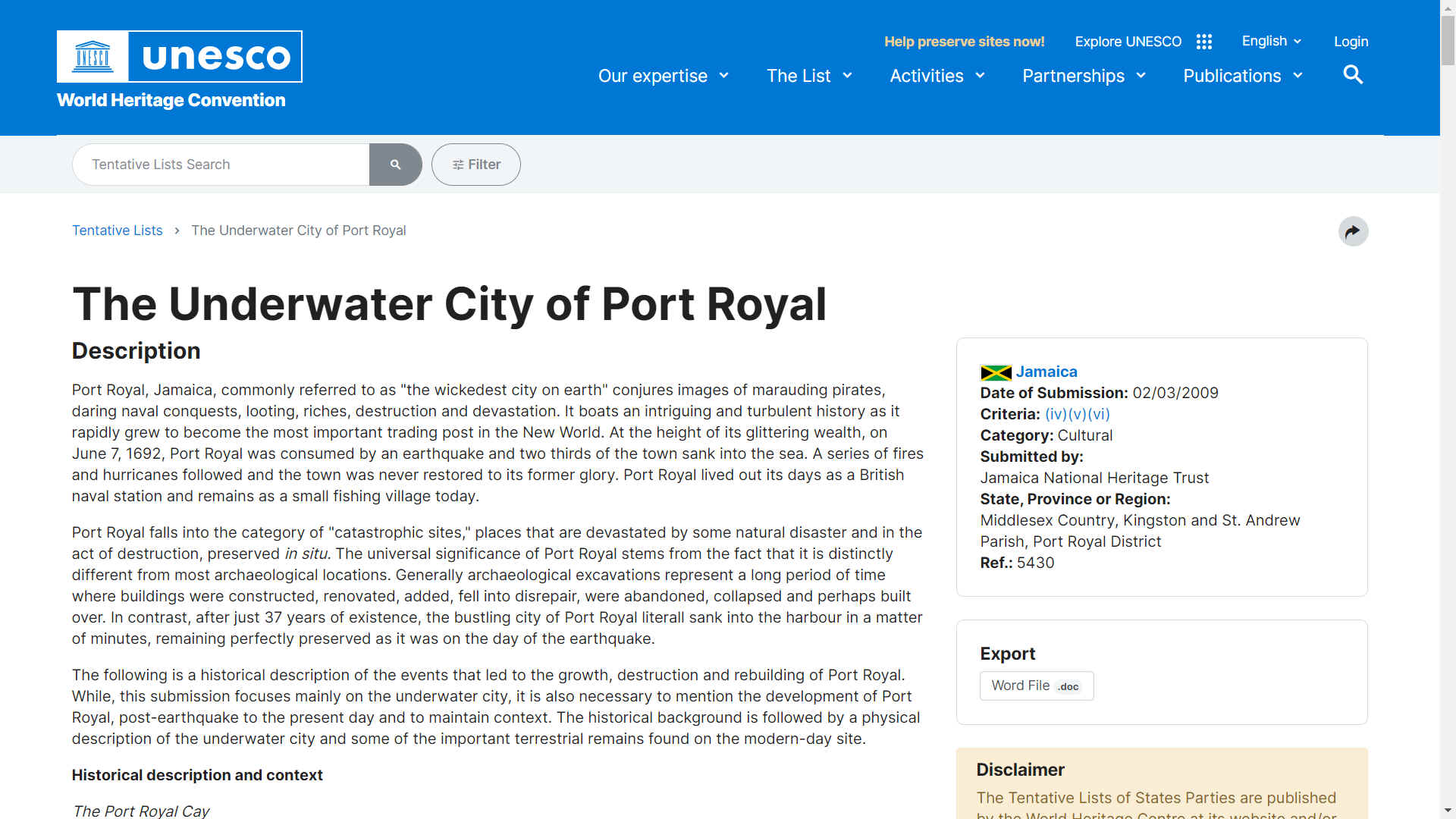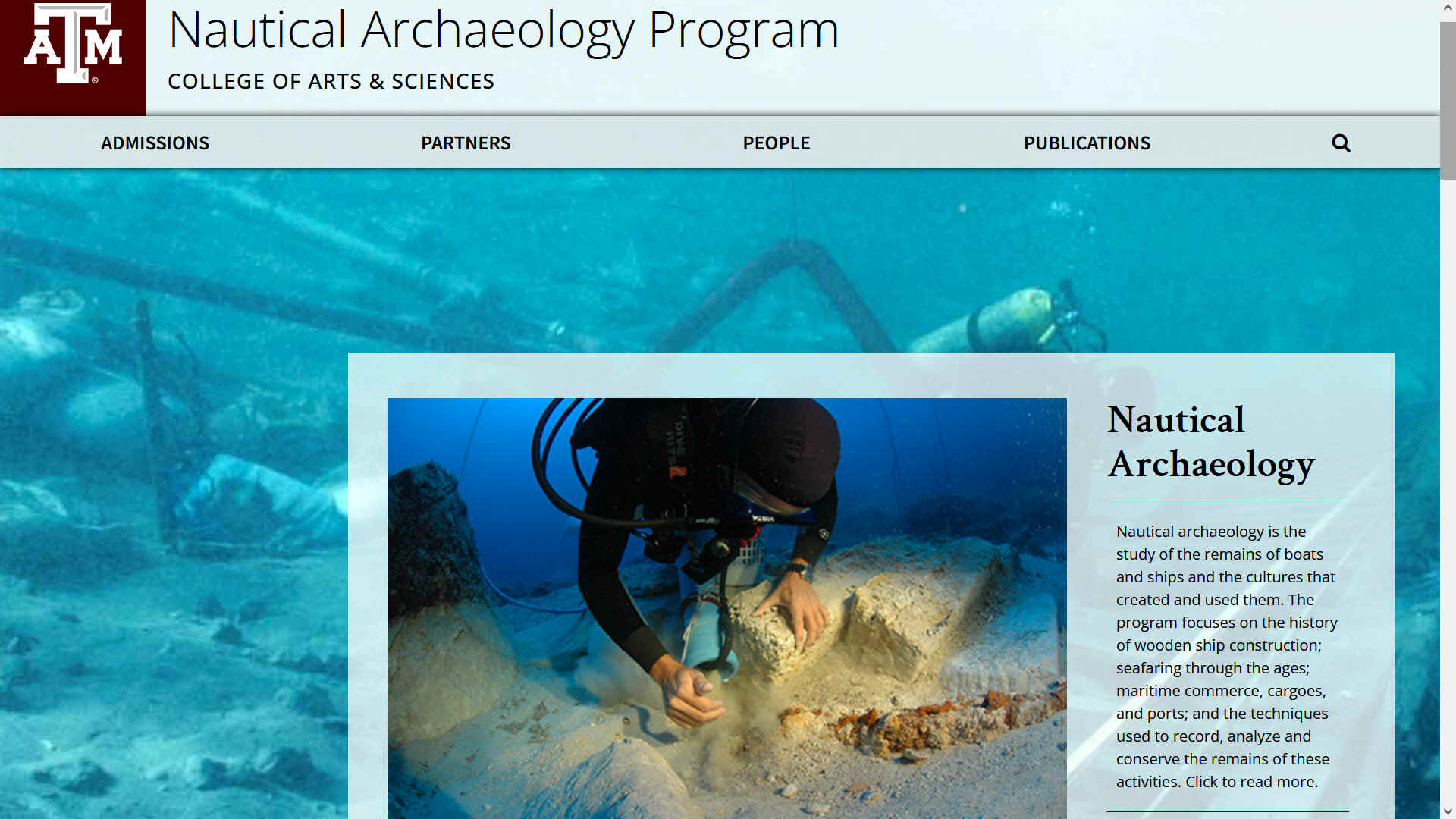
CG 73 PORT ROYAL - "THE WILL TO WIN"
The shield's dark blue and gold are the colors traditionally associated with the Navy. Red is emblematic of courage and sacrifice. Gold denotes excellence and high ideals; blue refers to the sea in which Port Royal sails. The blue and gray of the shield recall the Union and Confederate forces and the first Port Royal's Civil War service, while the embattled pile alludes to the forts on either side of Port Royal Sound. The trident represents an Aegis symbol of seapower and is enflamed to symbolize past and present weapons and defense. The tines of the trident represent an Aegis cruiser's capabilities: on the surface, the subsurface, and in the
air. The upward thrust of the trident head highlights the vertical launch capabilities of CG 73.
The crest's demi-palmetto tree, adapted from the State flag of South Carolina, alludes to the Port Royal Sound and the Carolina Sea Islands where the battles
occurred for which the ship is named. The sword and musket, crossed to express combined arms and joint service teamwork, signify the two Port Royals. The musket recalls the Revolutionary War battles and when combined with the Civil War Naval sword symbolize a continuing heritage of devotion to country, duty and the defense of freedom. The stylized Aegis array emphasizes the industrial and naval team which resulted in the American technological achievement of the Aegis combat system, while the lightning flash represents the ship's strike capabilities.
The ship's motto is an azure edged scroll with inscribed "THE WILL TO WIN" in
gold. The seal shows the coat of arms in full color as in the blazon, all upon a white background and enclosed within a dark blue oval border edged at top and CG 73 base all in gold.
The mission of the USS Port Royal is to be ready to conduct prompt, sustained combat operations at sea in support of USS JOHN C STENNIS Carrier Battle Group, Surface Actions Groups, Amphibious Assault Groups, and as an integral part of Interdiction Forces. Port Royal can operate in any threat environment.
Its diverse combat capability is orchestrated by the Aegis Weapons System, the only fully integrated Electronic Detection, Engagement and Fire Control System in the world.
The Port Royal is ready to conduct prompt, sustained combat operations at sea in support of carrier battle groups, surface action groups, amphibious assault groups and as an integral part of interdiction forces. Port Royal can operate in any threat environment. Port Royal can defeat hostile surface ships,
submarines, and air forces simultaneously, while delivering long range offensive land attacks. Port Royal's diverse combat capability is orchestrated by the AEGIS Weapons System, the only fully integrated electronic detection, engagement and fire control system in the world today. AEGIS enables Port Royal to detect, evaluate and engage an enemy with the greatest firepower and accuracy of any combat system. Port Royal's weapons include Standard
surface-to-air
missiles (SAMs), Harpoon antiship missiles, TOMAHAWK cruise
missiles, antisubmarine rockets, torpedoes, Phalanx Close-In Weapons Systems for self defense against enemy aircraft and missiles, and five-inch, rapid fire deck guns.
These weapons are supplemented by electronic warfare countermeasures, decoys and passive detection systems. Port Royal's antisubmarine warfare suite is equally unmatched. Port Royal's trio of underwater surveillance equipment consists of a hull-mounted
sonar, an acoustic array sonar towed behind the ship, and the SH-60B LAMPS MK III Helicopter. Together these systems give the Port Royal the capability to detect and prosecute submarines over 100 miles away, making it a true multi-warfare mission capable combatant. Four powerful
fossil fuelled
gas turbine engines propel Port Royal to speeds greater than 30 knots with ease and quickness. Two controllable reversible pitch
propellers assist in it's rapid acceleration and uncanny maneuverability.
The life of USS Port Royal (CG-73) as an AEGIS cruiser began at Ingalls Shipbuilding division of Litton Industries in Pascagoula, MS, with the start of fabrication work on November 9, 1990. CG-73's keel was laid on October 18, 1991. CG-73 was launched on November 20, 1992, and was christened on December 5, 1992, by Mrs. Susan G. Baker, wife of then Chief of Staff and Senior Counselor to the President, James A. Baker III. On December 6, 1993, CG-73 sailed into the Gulf of Mexico for her first predelivery sea trials. The ship was delivered to the U.S. Navy by Ingalls on April 25, 1994, in preparation for formal commissioning ceremonies on July 9, 1994, in Savannah, GA.
Port Royal is the 27th Aegis Cruiser, and the last cruiser to be constructed in the 20th century. Port Royal was also the first cruiser to integrate women into the crew, a process which was accomplished smoothly with great success.
The USS Port Royal was one of the first two US Navy first ships to receive TBMD system modifications and SM2 Block IV-A missiles, as part of the US Navy Theater Ballistic Missile Defense (TBMD). It was scheduled to conduct at-sea testing, develop core doctrine and tactics, and serve as focal points for developing the very latest theater ballistic defense technology. The USS Port Royal, along with the USS Lake Erie, has served as an operational unit for the development of doctrine and training, in addition to performance validation of the Navy Area TBMD Program.
The Port Royal deployed in March 1996 as part of a battle group centered on the aircraft carrier USS Nimitz to the waters near Taiwan. The Nimitz battle group was the second carrier task force deployed to the area where tension were building over Chinese military exercises and missile tests just off Taiwan.
In 1997, the USS Port Royal (CG 73) conducted surface and air defense operations for the
USS Nimitz (CVN 68) battle group, as it was operating in the Persian Gulf in support of the U.S. and coalition enforcement of the no-fly-zone over Southern Iraq.
The USS Port Royal (CG 73) underwent successful LINEBACKER sea trials at the
Pacific Missile Range, Kauai, Hawaii, in the fall of 1998. The Port Royal was next scheduled to participate in at-sea TBM target tracking events that same fall.
The USS Port Royal took part in the Northern Edge '99 Exercise. During Northern Edge '99, the Navy's Modeling and Simulation Center and the Army's Space and Missile Defense Battle Lab ran simulations which assessed the effectiveness of planned defenses against the missile threat. The USS Port Royal was connected to the TMD cell and shared warning information.
Port Royal departed on her second deployment in January 2000 as part of the USS John C. Stennis (CVN 74) Carrier Battle Group on deployment to the western Pacific and
Arabian
Gulf. She returned in June. She supported Operation Southern Watch in the Arabian Gulf and participated in
United Nations Maritime Interception Operations. Port Royal enjoyed an historic port visit to Durban, South Africa, the first U.S. Navy ship to visit in over 25 years. While in Durban, more thant 10,000 visitors toured the ship. The ships made port calls in Hong Kong, Dubai, Cape Town South Africa, Mauritius, and Darwin, Australia.
Following her return, the USS Port Royal entered dry dock on August 18, 2000, marking Port Royal's first dry-docking since new construction in 1994. Repair of voyage casualties to the port hub and sonar dome were the hottest items for the dry dock period. Also accomplished during the dry-docking were numerous combat systems and quality of life upgrades. The USS Port Royal (CG 73) undocked from
Pearl Harbor Naval Shipyard Dry Dock One on the evening of October 24, 2000, before conducting sea trials during a two-day underway at the end of the month. The Port Royal was afterward scheduled to make a shakedown cruise to Tahiti, French Polynesia in November.
USS Port Royal conducted a Naval Surface Fire Support (NSFS) FIREX I exercise off the southeast coast of San Clemente Island on the morning of May 9, 2001. The first series of missions were spotter service exercises which were primarily conducted to train new Marine Corps spotters. Upon completion of the spotter services, the FIREX I began. The ship's forward gun mount (MT51) fired 72 rounds rounds before a gun-loading casualty rendered it inoperative. The following day, the aft gun mount (MT52) suffered a minor casualty to the lower hoist assembly. Port Royal nevertheless executed the remaining five missions of the FIREX I which included a coordinated illumination mission.
The USS Port Royal deployed on November 17, 2001, departing Pearl Harbor two months before their scheduled deployment date, and conducted patrols the North Arabian Sea and Persian Gulf, as part of the John C. Stennis Battle Group in support of Operation Enduring Freedom.
WESTPAC 03 / ESG 1
Port Royal deployed Sept. 2, 2003 with ESG 1, supporting a Chief of Naval Operations and Commandant of the Marine Corps-sanctioned strike group experiment designed to provide forces that are more flexible in the global war on terrorism.
Port Royal, the last of the Ticonderoga-class of AEGIS guided-missile cruisers, performed duties as Air Defense Commander (ADC) for the seven-ship flotilla. Port Royal operators controlled the network of sensors, data-links, missile systems and Marine Corps aircraft that combined to form an air defense umbrella over ESG 1 ships and Marines ashore.
At various times, Port Royal was also assigned as the ADC for all Persian Gulf maritime operations. During these periods, Port Royal tracked all U.S. and coalition aircraft operating over the Persian Gulf in support of Operation Iraqi Freedom. Port Royal used the AEGIS system and associated Command and Control networks flawlessly in performance of these complex and demanding duties.
The ship served as "platform of choice" for the 13th MEU's Force Reconnaissance Platoon for Visit, Board, Search and Seizure operations.
With Port Royal acting as on-scene commander, the cruiser/USMC team intercepted and boarded a suspect
fishing dhow Dec 31, that was discovered to be smuggling 2,800 pounds of hashish with an estimated street value of $11 million. The 15 dhow crew members, suspected of possible links to the Al Qaeda terrorist network, were detained and delivered to coalition forces ashore.
In addition to a variety of security cooperation exercises with countries in the U.S. Central Command/5th Fleet area of responsibility, Port Royal Participated in Exercise Sea Saber, the fifth in a series of multi-national exercises based on the Proliferation Security Initiative (PSI) announced by President
George Bush in May 2003 in Krakow, Poland.
USS Port Royal returned home to Pearl Harbor March 11, 2004 following a six-and-a-half month deployment with Expeditionary Strike Group (ESG) 1.
USS PORT ROYAL (1862-1866)
USS Port Royal a 1163-ton "double-ender" side wheel steam gunboat, was built at New York City. Commissioned in April 1862, she was soon in action against the Confederates in the Hampton Roads and James River areas, taking part in bombardments at Sewell's Point on 8 May and Fort Darling on 15 May. In August, she covered the Army's withdrawal from Harrison's Landing. Later in 1862, Port Royal operated on the North Carolina Sounds.
The gunboat was next assigned to the Gulf of Mexico blockade, raiding Apalachicola, Florida, in April and July 1863 and capturing a sloop in May. In August 1864, Port Royal participated in operations in Mobile Bay, entering the bay with Farragut's fleet on the 5th and later assisting in the bombardment and capture of Fort Morgan. Remaining in the Gulf beyond the end of the
Civil
War, USS Port Royal was decommissioned in May 1866 and sold in October of that year.
PORT ROYAL
CG-73 is the second U.S. Navy warship named to commemorate battles of the American Revolution and the Civil War in the waters of Port Royal Sound and on the adjacent South Carolina sea islands. In February 1779, South Carolina troops under the command of Colonel William Moultrie repelled an attempted British amphibious attack. In November 1861, a combined Union Army-Navy expedition, under the command of Flag Officer Samuel du Pont, captured the island, which became the principal
coaling and refitting base for the Southern Blockade Squadron.
CONTACTS
..

A
diver using SCUBA gear to explore Port Royal
UNDERWATER
ARCHAEOLOGY EXCAVATION AT PORT ROYAL - CARIBBEAN SEA
Underwater explorations and excavations have been conducted in Port Royal over the years. Here is a listing of such excavations. After the 1692 earthquake, people tried to
salvage anything considered to be valuable from the area, which became known as the Sunken City.
1859: Jeremiah Murphy a naval diver, using a diving bell located the remains of Fort James.
1956 - 1959: Edwin Link dug test pits in the King's Warehouse and Fort James.
1960:
Norman Scott explored Fort Carlisle.
1965 - 1968: Robert Marx excavated between twenty to thirty buildings in the Sunken City.
1969
- 1970: Philip Mayes Excavation. Mayes was hired by the Jamaican National Trust Commission to continue research. Mayes is accredited with uncovering
St. Paulís Church of Port Royal, the largest building of the 17th century city.
1981 - 1990: Institute of Nautical Archaeology of the Texas A&M
(Agricultural & Mechanical) University in close cooperation with the Archaeology Division excavated buildings near the intersection of Queen and High Street.
An
earthquake in the Caribbean
struck Port Royal, Jamaica, on
the 7th of June 1692. A stopped pocket watch found in the harbor during a 1959 excavation
conducted by Edwin
Link and his wife Marion, indicated that the resultant tsunami occurred around 11:43 AM local time.
Known as the "storehouse and treasury of the West Indies" and as "one of the wickedest places on Earth", Port Royal was, at the time, the unofficial capital of Jamaica and one of the busiest and wealthiest ports in the Americas, as well as a common home port for many of the privateers and pirates operating on the
Caribbean
Sea. Sometimes called the Sodom of the Universe.
The 1692 earthquake caused most of the city to sink below sea level. About 2,000 people died as a result of the earthquake and the following tsunami, and another 3,000 people died in the following days due to injuries and disease.




